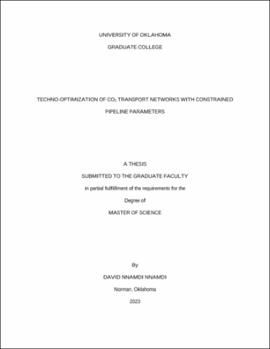| dc.description.abstract | In planning large scale carbon sequestration projects, one of the key parameters affecting project economics is the selection of optimal pipeline transportation networks connecting physical locations of carbon sources to sinks (or injection sites). This network is usually determined based on several limiting factors including existing right-of-way, densely populated regions, topology, etc. Open-source tools such as SimCCS2.0 do an effective job in proposing provably optimal routes for construction of new pipelines but are unable to accommodate existing pipelines in techno-economic optimization. With the newly amended 45Q laws offering 70% more tax credits for carbon sequestration than it did in the 2018 amendment, energy companies are looking more into repurposing gas and liquid transportation lines for CO2 transportation to abandoned oil and gas wells for carbon storage and this has further bolstered the need to have a method to account for existing pipelines in sequestration economics.
This project demonstrates a method to account for existing pipelines by 1 introducing zero cost paths into the cost surface to represent pipelines, 2 allowing for tie points into the existing pipeline by use of cost exclusion zones around zero cost paths and then, 3 calculating least cost paths and defining transshipment nodes along pipeline intersections. Doing this allowed for a reformulation of the alternate network paths between sources and sinks, and the network was then solved as Minimum-Cost-Network-Flow-Problem (MCNFP) modeled as a mixed integer programming problem.
The solution was developed using Python programming language and demo test cases are shown to illustrate the effectiveness of the solution in assessing cost reduction associated with CO2 transfer from sources tied into locations along existing transport pipelines to sinks.
This solution has been packaged into a software name Sequestrix and has been made publicly available on GitHub for researchers and economic analysts to take advantage of for evaluating large scale CCUS projects, and to encourage further development and collaboration. | en_US |
